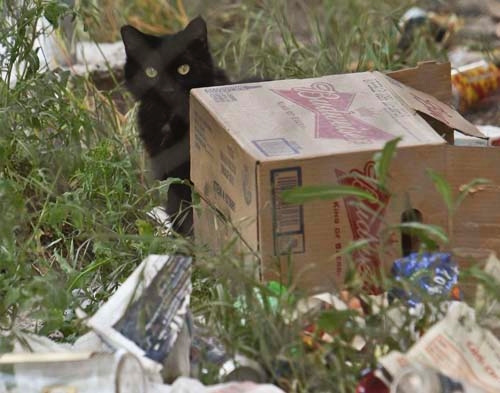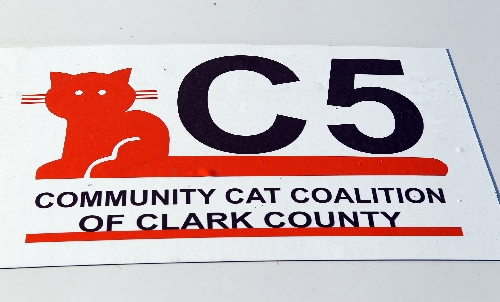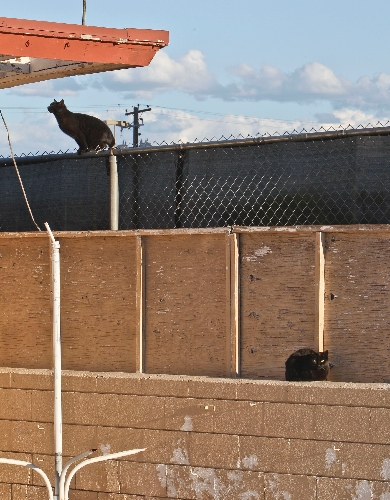Advocates look to control population of feral cats roaming Strip
The black cat is oblivious.
It lounges on the roof of the shuttered White Sands motel, tucked in a shady spot, unaware that three humans are approaching. A "no trespassing" sign is posted only a few feet away but the cat is oblivious to that, too.
To some people, including the owners of this dilapidated Strip motel, the cat is an intruder. They don't want it here, or anywhere, really. The cat is feral, part of a colony of feral cats that some number between 30 and 200.
White Sands is an example of an out-of-control feral cat colony. It is one of the few unsupervised colonies on the Strip, says Keith Williams, director of Community Cat Coalition of Clark County, or C5. He is the volunteer supervisor of the city and county's feral cat colony registration program.
If it surprises you that feral cats live on the Strip, it shouldn't. Las Vegas has a major feral cat problem. Williams says the valley is home to more than 300,000 free-roaming cats. Some of those felines live in ditches, on golf courses and on hotel grounds along Las Vegas Boulevard.
"I don't believe there are 200 cats here," Williams says, approaching the oblivious cat at White Sands. In his experience, the average feral cat colony covers about 10 acres, a population density of one cat per acre. "The largest colonies I've seen are 50 to 60 cats. I would be surprised if there were 100, let alone 200, cats here."
The estimate is probably a tall feral cat tale, arrived at by well-meaning people who devote their free time and money to feeding the White Sands felines. It is those people who are partly to blame for the out-of-control colony. They are maverick animal lovers who will not stand for an animal going hungry, so they feed the cats but do not spay or neuter them, making them fat and healthy reproducers.
The property owners compound the problem, refusing to allow Williams to use his official resources - the trap, neuter, return program or TNR - to get the situation under control. Both Clark County and Las Vegas have ordinances that make it legal for people to supervise and take care of feral cat colonies. Under those rules, they must trap the cats, spay or neuter them, return them to their territory and allow them to live out their natural lives.
So far, there are 482 registered colonies in the valley. Williams is reluctant to say how many are on the Strip. When colonies are identified, it can endanger the cats or encourage people to dump their own cats there, Williams explains.
The TNR program is working, Williams says. In just a few years, local animal shelters have experienced a decline in the number of cats taken in; 90 percent of shelter cats are strays. Supervised colonies are also shrinking. Each year, the population of a feral cat colony naturally decreases by 20 percent to 50 percent, but those missing cats are replaced by kittens. There are no kittens in controlled colonies.
CAT CARETAKER
Her hotel co-workers know her as the Cat Lady.
You will know her only as Cat Lady because she cannot be identified. To name her or the Strip hotel where she works could put her job in jeopardy. And that would endanger her colony of feral cats.
So Cat Lady remains anonymous.
When she started her job more than 10 years ago, Cat Lady noticed cats around the property. At first, she did nothing because they weren't her cats. Every now and then, she would hear about raids where Animal Control stormed the hotel grounds and rounded up the usual suspects, feral cats. Such raids barely made a dent in the population.
About four years ago, Cat Lady, a lifelong animal lover, started feeding the cats. A year later, she connected with Williams and began trapping, spaying and neutering the cats, then returning them to their hotel. She's noticed a difference; the population is healthy and declining naturally, Cat Lady says.
Only a handful of cats remain.
In all the years she's been helping these feral cats, "I've had one manager say I have to get rid of those cats," she says. He wasn't around for long. Now, management is supportive of her efforts but she still keeps a low profile, just in case. She has heard of other caretakers on the Strip whose jobs have been threatened for feeding stray cats.
"I try to stay under the radar, but I also like to let people know that I'm doing this so they will tell me about cats," Cat Lady says.
Though C5 organizes and covers the costs of spaying, neutering and veterinary care for the ferals, the food for Cat Lady's colony comes out of her own pocket. No one has ever offered to help her trap or given her money for food. That's OK with her, though. She has taken on the burden of a problem that was never hers, but she has to help.
"If not us, then who?" Cat Lady says of her fellow colony caretakers. "I like cats, and there's a total need for someone to step in and take care of the problem. Somebody's got to do it. Some people just don't have a whole lot of money to do this, but there's a need and they love cats and they can't just stand by and watch the cats suffer."
COMMITTED TO CARE
When Angela Lamar, 42, pulls up in her white Hyundai, there are no hints of what her trunk may hold.
A couple of cat-positive stickers decorate her car, but that's nothing unusual. Maybe her being parked by a drainage ditch on the Strip hints at something.
It's only when she opens her trunk and you see the giant container of cat kibble, the cans of cat food, the water and other cat accoutrements, that you understand Lamar is serious about this feral cat colony thing. All volunteers' cars look like this, she says.
Lamar fills a bucket with kibble and stirs in wet cat food, some tuna- flavored meal. She crawls into the drainage ditch and starts moving trash aside. Fast-food cups and wrappers, discarded beer cartons and unidentifiable garbage litter the roadside. The mother of three reaches into one of the narrow drains and pulls out a beat-up food dish. She fills it and wedges it against a rock.
Lamar works in customer service for a local company. About five years ago, she was driving home along the Strip and saw some cats roaming around.
"I didn't see anyone feeding them so I'd put a handful of cat food down and it would be gone the next time," she says. "I was just driving by, going to work, and I would just stop and drop."
Now she is the official caretaker for this feral cat colony that contains about 30 cats. Their territory covers an area of the Strip near the Bali Hai golf course. Three days a week, Lamar places food in the ditch along Las Vegas Boulevard.
No one sets out to be a feral cat caretaker, Lamar says.
One day, you're putting some kibble outside for the tomcat that rummages through your garbage.
Before you know it, you're spending $240 a month on cat food, burning up your gasoline, driving around town to feed dozens of untamed cats.
"Once I started this, frankly I never thought it would go this far," Lamar says. "It does take time away from your family. You kind of do have to love the kitties and be committed to it."
CAT TALE
The old Hacienda hotel might have been ground zero for feral cats.
It was imploded in 1997, making way for what is now Mandalay Bay. When it opened in 1956, the floors were dirt, says Cathy Henson, a former Hacienda employee and a volunteer for local cat organizations. For years during the 1970s, she took care of a feral cat colony in the Hacienda's garage, feeding the cats and getting them spayed and neutered long before a county ordinance was in place.
In the hotel's early days, they had a problem with field rats, Henson says. So one day the owner's wife went to the shelter and got a bunch of stray cats. She brought them back and released them on the grounds. Field mice problem solved. The cats became furry heroes, and the cat stories became casino lore.
"There were times when the cats would fall through the ceilings into the cashier's cage," Henson remembers.
It is very likely that those cats reproduced and became a feral cat colony over time. It's also possible that other hotels used similar extermination methods during the Strip's early days. One thing is certain, the Strip has always been surrounded by residential neighborhoods where people let their cats roam, Williams says. Hence, the presence of cats on the Strip.
When the Hacienda was imploded, volunteers trapped the remaining cats and relocated them. In fact, throughout the Strip's implosion history, volunteers have been sneaking onto properties before they were imploded, removing feral cats to prevent their deaths.
PUBLIC AWARENESS
Maybe you think these feral cat people are crazy and you know how to fix the valley's feral cat problems.
You don't.
Round them up, take them to the pound, exterminate them? It's been done. It doesn't work. If you don't address the problem at its source, reproduction, then you're only making room for more cats, Williams says. There will always be replacement cats, until the general public learns that it must spay and neuter its pets.
Besides, no government agency has the resources to collect 300,000 stray cats in the valley.
Perhaps you think the cats should be trapped and moved. Not a good solution, either. Feral cats are great navigators and will try to find their way back to their territories, Williams says. And cats are wily. You may think you can round them all up, but you will miss a few. Herding cats is hard.
Plus, there are no volunteers for rounding up cats just to send them to their deaths, Williams says. Cat lovers don't do that.
White Sands should serve as a cautionary tale. No uncontrolled feeding - it doesn't help the problem. And more cooperation from property owners would help, Williams says, approaching the oblivious cat at White Sands. When the humans are within 30 feet of the seemingly oblivious cat, it jumps up and darts out of sight. It wasn't so oblivious after all.
Contact reporter Sonya Padgett at spadgett@ reviewjournal.com or 702-380-4564. Follow @StripSonya on Twitter.































